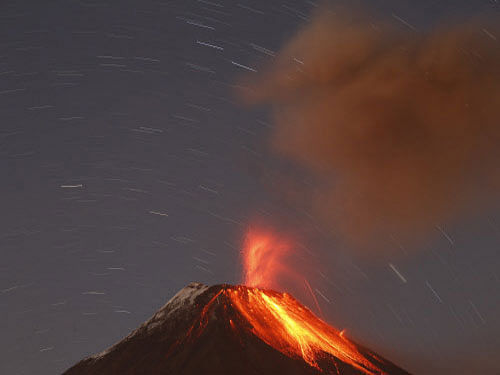Volcanoes go quiet before they erupt: study
Last Updated IST

When dormant volcanoes are about to erupt, they show some predictive characteristics - seismic activity beneath the volcano starts to increase, gas escapes through the vent, or the surrounding ground starts to deform.
Periods of seismic quiet occur immediately before volcanic eruptions and can thus be used to forecast an impending eruption for restless volcanoes, scientists say.
When dormant volcanoes are about to erupt, they show some predictive characteristics - seismic activity beneath the volcano starts to increase, gas escapes through the vent, or the surrounding ground starts to deform.
However, until now, there has not been a way to forecast eruptions of more restless volcanoes because of the constant seismic activity and gas and steam emissions.
Diana Roman, a volcanologist at Carnegie Institution for Science (CIS) in the US, working with a team of scientists from Pennsylvania State University, Oxford University, the University of Iceland found that periods of seismic quiet occur immediately before eruptions and can thus be used to forecast an impending eruption for restless volcanoes.
The duration of the silence can indicate the level of energy that will be released when eruption occurs. Longer quiet periods mean a bigger bang.
The team monitored a sequence of eruptions at the Telica Volcano in Nicaragua in 2011. It is a so-called stratovolcano, with a classic-looking cone built up by many layers of lava and ash.
They started monitoring Telica in 2009 with various instruments and by 2011 they had a comprehensive network within four kilometres of the volcano's summit.
The 2011 eruptive event was a month-long series of small to moderate ash explosions. Prior to the eruption, there was a lack of deep seismicity or deformation, and small changes in sulphur dioxide gas emissions, indicating that the eruption was not driven by fresh magma.
Instead, the eruption likely resulted from the vents being sealed off so that gas could not escape. This resulted in an increase in the pressure that eventually caused the explosions.
Of the 50 explosions that occurred, 35 had preceding quiet periods lasting 30 minutes or longer. Thirteen explosions were preceded by quiet intervals of at least five minutes. Only two of the 50 did not have any quiet period preceding the explosion.
"It is the proverbial calm before the storm. The icing on the cake is that we could also use these quiet periods to forecast the amount of energy released," said Roman.
The researchers did a "hindsight" analysis of the energy released and found that the longer the quiet phase preceding an explosion, the more energy was released in the ensuing explosion.
The quiet periods ranged from six minutes before an explosion to over 10 hours for the largest explosion.
The researchers were also able to forecast a minimum energy for impending explosions based on the data from the previous quiet/explosion pairs and the duration of the particular quiet period being analysed.
The research was published in the journal Earth and Planetary Science Letters.
When dormant volcanoes are about to erupt, they show some predictive characteristics - seismic activity beneath the volcano starts to increase, gas escapes through the vent, or the surrounding ground starts to deform.
However, until now, there has not been a way to forecast eruptions of more restless volcanoes because of the constant seismic activity and gas and steam emissions.
Diana Roman, a volcanologist at Carnegie Institution for Science (CIS) in the US, working with a team of scientists from Pennsylvania State University, Oxford University, the University of Iceland found that periods of seismic quiet occur immediately before eruptions and can thus be used to forecast an impending eruption for restless volcanoes.
The duration of the silence can indicate the level of energy that will be released when eruption occurs. Longer quiet periods mean a bigger bang.
The team monitored a sequence of eruptions at the Telica Volcano in Nicaragua in 2011. It is a so-called stratovolcano, with a classic-looking cone built up by many layers of lava and ash.
They started monitoring Telica in 2009 with various instruments and by 2011 they had a comprehensive network within four kilometres of the volcano's summit.
The 2011 eruptive event was a month-long series of small to moderate ash explosions. Prior to the eruption, there was a lack of deep seismicity or deformation, and small changes in sulphur dioxide gas emissions, indicating that the eruption was not driven by fresh magma.
Instead, the eruption likely resulted from the vents being sealed off so that gas could not escape. This resulted in an increase in the pressure that eventually caused the explosions.
Of the 50 explosions that occurred, 35 had preceding quiet periods lasting 30 minutes or longer. Thirteen explosions were preceded by quiet intervals of at least five minutes. Only two of the 50 did not have any quiet period preceding the explosion.
"It is the proverbial calm before the storm. The icing on the cake is that we could also use these quiet periods to forecast the amount of energy released," said Roman.
The researchers did a "hindsight" analysis of the energy released and found that the longer the quiet phase preceding an explosion, the more energy was released in the ensuing explosion.
The quiet periods ranged from six minutes before an explosion to over 10 hours for the largest explosion.
The researchers were also able to forecast a minimum energy for impending explosions based on the data from the previous quiet/explosion pairs and the duration of the particular quiet period being analysed.
The research was published in the journal Earth and Planetary Science Letters.